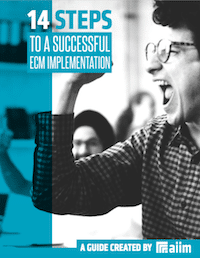The AIIM Blog
Keep your finger on the pulse of Intelligent Information Management with industry news, trends, and best practices.
Enterprise Content Management (ECM) | Sharepoint and Office 365
With the release of SharePoint 2010 in beta and the anticipated production release sometime in the first half of 2010 (one source says it will be released late in Q1, but that’s a full-blown rumor, so don’t hold me to that), it is time to provide an update on the latest incarnation of Microsoft’s collaboration/content management/business intelligence/portal/ECM/records management tool. In an earlier post, I listed Eight Things SharePoint 2010 Needs to be a True ECM System, and, at first glance, the new version looks very encouraging from an ECM perspective. As I’ve said before, I get excited by anything that can help my clients better manage their information, and SharePoint has the potential to be a transformative platform bridging structured content, unstructured content, and social computing in one flexible package. SharePoint 2007 does a decent job of this, but it has some deficiencies when it comes to managing all content in the enterprise.
Share
Enterprise Content Management (ECM)
OK, you’ve found what appears to be a great software product that solves a critical business issue (and at a great price), so you talk to a “decision-maker” – this might be your boss, the CIO, or maybe a regional controller. You present some of your findings (based on a “live” demonstration), and before you can finish, they want to know everything about the software vendor…not a bad thing, it’s part of the due diligence process. Unfortunately, because the software vendor does not appear in Gartner’s “Magic Quadrant” or is not considered a “Top 5” player, your idea is quickly dismissed because “…they’re too small and therefore too big a risk for our company.” You feel a little intimidated; maybe even embarrassed that you suggested the idea and are thinking this might be the last time you stick your neck out. Obviously, you don’t want to play high-stakes poker with your employer’s money – so is your idea that crazy (simply because it’s a small software vendor)?
Share

Making an ECM implementation successful requires planning and attention to detail. The best way to create the right solution is to identify organizational goals and priorities. Learn how to manage a successful implementation in our free guide.
Enterprise Content Management (ECM)
Gather high-level enterprise business requirements. Once you have high-level direction from your stakeholders on scope, objectives, and success factors, you will be well-positioned to start defining your ECM strategy and implementation plan. Conduct document surveys with key representatives from each business unit/organization to understand what content your company has and what content needs to be managed. Use this opportunity to gather high-level requirements as well as possible improvements in managing the content. Also, meet with regulatory representatives and understand their perspective on content across the enterprise. This initial work will set a base for the enterprise implementation strategy as opposed to departmental implementations.
Share
Enterprise Content Management (ECM) | Healthcare
Let's start with a hypothetical scenario. I woke up to the sound of my car horn blaring and a woman standing over me with a golf club. My car was conveniently parked against a tree, with a plume of water shooting over my head like fireworks from a nearby fire hydrant. My chest hurt - a lot. When I got to the hospital in the ambulance, I informed them of the pain. They told me they were going to do an EKG just to be sure everything was okay. I shared that I had just had an EKG done at the same hospital two weeks ago. They got on their fancy computer and pulled up my “electronic medical record.” Unfortunately, the nurse informed me that my EKG didn’t show up because that wasn’t ‘structured data’ that fit nicely in their EMR. The nurse said that my EKG was in a paper chart down in Medical Records – which was closed for the night. I said, “Do you know who I am?”
Share
Enterprise Content Management (ECM) | Information Security | Intelligent Information Management (IIM)
Why You Need an Information Strategy For many years, organizations have survived by "winging it" when it comes to information management.
Share
Cloud | Document Management | Enterprise Content Management (ECM)
I'm a big fan of all those year/decade retrospectives and year/decade prediction lists that appear this time of year. Just for fun - and to keep what we do in the content, document, and records space in a bit of perspective - here on the left side of this post is the Google predictive text for "2010 predictions." So I guess we have a bit of a way to go before our industry is top of mind. Hey, there's a big surprise! Before venturing into my own (modest) predictions in a future post, here are a few I really found intriguing -- by people way smarter than me.
Share